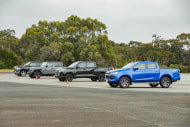
What does GVM mean?
Gross Vehicle Mass, or GVM. You’ve probably seen that written on the tailgate of a delivery truck or on the quarter panel or bottom of the door on an old courier ute or van.
Gross Vehicle Mass, or GVM. You’ve probably seen that written on the tailgate of a delivery truck or on the quarter panel or bottom of the door on an old courier ute or van. The GVM, according to the NSW Department of Transport, is “the maximum total mass of a fully loaded motor vehicle as specified by the vehicle manufacturer”.
To put it another way, Transport South Australia states the GVM is “the maximum loaded weight of a rigid vehicle while driving on the road.”

You might also see this referred to as the Gross Vehicle Weight (GVW) or the Maximum Loaded Vehicle Mass (MLVM), but those two terms are less common.
If you aren’t sure what gross means in this context, it’s simply the amount of in its entirety. And while weight and mass aren’t strictly identical in meaning, they are passed off as such in this sort of documentation.
Here’s an example using a Mitsubishi Triton 4x4 as a case study.
The Triton GLX double cab pick-up automatic has a GVM of 2900kg. That means the maximum amount you’re allowed to have on board at any one time for that ute is exactly that - 2900kg.
If you deduct the kerb weight / kerb mass of the vehicle - which, in this example, is 1969kg, that means you have the remaining 931kg to “play with”, and that’s the payload figure.
(NOTE: The kerb weight of a vehicle is that vehicle with a full tank of fuel, all engine fluids, and no accessories fitted. If the paperwork doesn’t have kerb weight, but does list “tare weight”, that is the standard vehicle, but with only 10 litres of fuel.)
If you’re wondering where you will find the GVM, kerb or tare weight figures for your ute, it’ll typically be available on the manufacturer specs sheet, or in the owner’s manual, or on the weight placard (usually in the driver's door opening).

You need to know that everything you add to the vehicle has an impact on your GVM. That means if you add a bull bar, it’ll affect your GVM. So will a roof rack setup, a towbar, winch, toolboxes and all other accessories that are fitted to the body of the vehicle.
It is surprising how much weight you can add to a ute before you even think about loading anything in the tray, not to mention adding other people in the cabin, for that matter.
Further, one thing many people don’t think about is that when you’re towing something, it affects the GVM, too. That means that if you have a three-tonne trailer in tow, you need to consider the tow-ball down weight or tow ball download. For argument’s sake, it’s usually (not always) 10 percent of the trailer. All of a sudden you end up very close to the GVM limit, and that’s before you even think about your payload calculation and gross combination mass (GCM).
More Tradie Ute Guide


